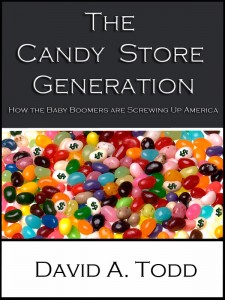As I’ve posted before, my next work-in-progress, after completion of In Front of Fifty Thousand Screaming People is The Candy Store Generation. This is a political book, telling my opinions of how the Baby Boomer generation has screwed up America. The title came from my impressions of the first of three presidential debates in 2000, Bush vs. Gore. I described the origin of the term in my friend’s political blog. I did three follow-up posts on the topic, but they aren’t all properly tagged. If you want to read them, follow the link, then go to newer posts till you get all four. And the most recent post on the blog (as of 1/30/2012) is another of my thoughts about the subject.
After letting the concept sit a couple of years, I decided it would be a good topic for a short book, maybe 30,000 to 40,000 words. Since I’m firmly within the Baby Boomer generation, I figured I could write about it. Research would be minimal; my opinions would be foremost. I decided I wanted to do research into average birth years of the House and Senate over time, to see when they flipped from one generation to the next. That’s fairly time consuming, but I’m close to half way through that.
I copied the four blog posts into one file, and discovered they only came to a little over 2,000 words. Yikes! I thought sure I had written more than that. I took a few days to think through the contents of the book. I came up with ten chapters I thought were needed. That meant 3,000 to 4,000 words per chapter. Given that the words already written were spread out over five of those chapters, I clearly had some work to do.
The first chapter came first. I took the 500 words already written and began expanding them. This chapter serves as an introduction, without much commentary, describing the genesis and purpose of the book. It explains my shock at how, during that debate, the two candidates treated a budget surplus that hadn’t happened. Over several days I added a paragraph here, corrected a sentence there, clarified something in another place. I think it was last Thursday that I counted chapter 1 complete, though of course subject to edits. The word count in the chapter: 1,200.
Well, the Introduction needs to be shorter, I thought. So I plowed into the second chapter, the one that defines what the different recent generations are in popular terms and what the most common characteristics are. I found it slow going. Thinking you can describe the dominant attributes of a generation is easy when you say in your head you are going to do it, harder to actually put the words on paper. I allowed myself to become distracted with many outside things.
On Saturday, rather than write in the book, I brainstormed what the book would contain. A couple of news stories gave me ideas, and I reworked my table of contents. It’s now up to 14 chapters, so the word count per chapter is down to something like 2200-2900. I realize that an artificial word count per chapter is not smart. Each chapter must tell its story in whatever words the story demands. But average chapter length is a good indication. If after a few chapters I’m way under or way over the range I’m looking for, that says either 1) the project is not viable in the length I’m protecting for it, or 2) it’s going to be a more significant work than I expected, and I may need to adjust some expectations and publishing schedule.
Finally, yesterday afternoon I was able to knuckle down. I drew some simple information from the Statistical Abstract of the U.S. and from a couple of websites—nothing I can link to as a reference, but they gave me some ideas and refreshed my memory as to what I already knew. I was still distracted, and still struggling for words, but I was able to work at it for a few, interrupted hours.
My writing goal for Sunday was 1,000 words. When my writing day was done, I had 1,250 words, all of them in Chapter 2. That’s not a complete chapter by any means, and I’ve barely begun discussing other generations. So it seems I ought to be able to make my word quota for the chapter with no problem. It looks like the chapter will be at least 2,500 words to contain everything I want it to, and maybe over 3,000. So far so good.
That makes me feel a lot better about the project. This is a political season, and I’d like to have to book available well before the election. I have no illusions it will be a best seller or that it would influence the political debate. But having a political book come out several months before an election can’t hurt.
 Actually, finding references, both scholarly and popular, on how one generation differs from another is easy. There is no end to the books written about the Baby Boomers. I found a couple of those references, and from them was able to extract some of the dominant characteristics of the Boomers, the Greatest Generation, the one in between them (often called the Silent Generation), and a little bit about Generation X and Generation Y.
Actually, finding references, both scholarly and popular, on how one generation differs from another is easy. There is no end to the books written about the Baby Boomers. I found a couple of those references, and from them was able to extract some of the dominant characteristics of the Boomers, the Greatest Generation, the one in between them (often called the Silent Generation), and a little bit about Generation X and Generation Y.

